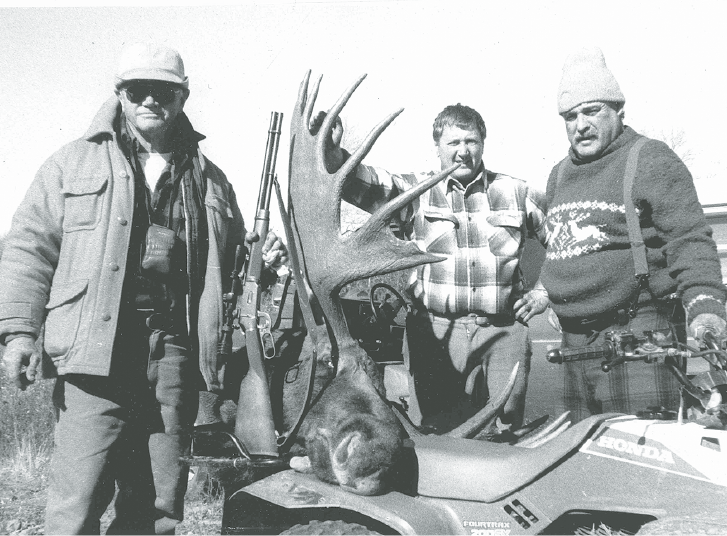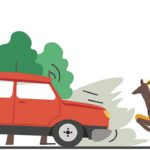More moose roamed the Minnesota North Shore’s backcountry in 1989. That year I was one of a party of four drawn in a lottery for an October moose hunting permit.
The license allowed us to take one moose. In addition to myself, the hunting party included my father Dan and his friends, Gene Huffman and Bill Anderson. Since I lived in Hovland, the pre-hunt scouting in our nearby hunting zone was my task. I roamed throughout the zone and picked the brains of folks who knew about moose.
The forest was different back then. After the Boundary Waters Canoe Area was designated as a wilderness area, timber harvest that occurred there came to a halt. The demand for wood remained, so harvest increased outside of the wilderness. Sweeping clearcuts that loggers left behind were perfect moose habitat. The big animals grazed on the woody growth that sprouted in the wake of logging. Vast areas of regenerating forests almost certainly contributed to the era’s abundance of moose.
Someone recommended a remote forest road passing through extensive cutovers. Checking it out, I found lots of moose sign and actual moose, including sightings of monstrous bulls. There was a lonely campsite on a small lake nearby. Our hunting plan fell into place.
We saw no moose on the first day of the season, except two animals just before dark, likely a cow and calf, across the lake from our campsite. At dawn of day two, Dad and I climbed a low ridge in a clearcut, then headed opposite directions along it. Immediately I happened upon a big bull with a cow. Unfortunately, Dad was already out of sight, because I wanted him to shoot his first, and likely only, moose. Turning back to the task at hand, I made the kill.
The bull was gigantic. You really can’t appreciate the size of a moose until you walk around a dead one lying on the ground. It took all four of us to dress and quarter the animal, then get the meat and antlered head out to the truck. When we registered the animal with the state DNR, we learned it was possibly the largest moose taken in Minnesota that year. A biologist said it may have weighed 1,200 pounds.
At the time, the DNR allowed moose hunting every other year and was conservative with the number of permits issued. Quality habitat and the cautious approach to hunting harvest likely contributed to moose abundance back then. How abundant were they? In the fall of 1989, I saw four other bulls that appeared to have antlers over 50 inches in width within a mile of where I killed the bull, which had antlers 54 inches wide. That’s a large, mature bull in Minnesota.
My point is not that I shot a trophy bull, but that such animals, and moose in general, were much more common than they are today. The preparation and culmination of that 1989 hunt led me deeper into the world of moose. My dogs frequently encountered moose while out on walks or while hunting grouse and ducks. More than once I had cow moose walk up nearly close enough to touch while fly-fishing for brook trout in beaver ponds. Three different times moose charged me; one was certainly not a bluff.
Moose were often seen while driving along backroads and even occasionally on Highway 61. While serving as a volunteer firefighter in the community of Hovland, I recall responding to at least three moose/vehicle accidents, including the fatalities of one person and at least three moose. I now can’t remember the last time I saw a moose along the highway.
In the woods, moose trails like sidewalks passed through the regenerating forests. In places, aspen sprouts were browsed so hard they looked like shrubs. It took the young aspens years to grow above the browsing height of wintering moose. Young balsams in the same places were girdled to a height of 10 feet by wintering moose. Such trees of either species are hard to find these days. In fact, more common are places with prime browse untouched by moose.
Seeking moose antlers (the bulls lose them every winter) was a great reason to go for long, spring dog walks. While I still have a few antlers, most were sold for a reasonable price per pound. At the time, there was also a market for moose skulls and femur bones. I sold those to a local fur buyer to cover the gasoline costs of my dog walks.
The gradual decline in the moose population became apparent in the early 2000s. Folks who spent a lot of time in the woods were the first to remark they were seeing fewer moose or signs of moose activity. They began talking about the “ghost moose” that appeared in the spring, showing hair loss from winter tick infestations. “Drunk moose,” staggering victims of a brain parasite transmitted by white-tailed deer, made the news from Duluth to Canada. Deer numbers exploded a few years after the animals were decimated by a pair of deep-snow winters. Deer hunters began hunting in areas previously dominated by moose as whitetails appeared in huntable numbers.
While the above factors worked against moose, so have others less often mentioned in public discussion. Moose hunting by state, provincial and Indigenous hunters continued even when it was apparent their population was in a freefall. More importantly, a rapid decline in the demand for paper and other forest products led to the closure or reduced production of many mills along the North Shore and across the North. As the timber industry was downsized, so too was the logging that created moose habitat. While the regrowth following wildfires provides some habitat, such fires are actively suppressed across much of the former moose range. Expanding human development nearly guarantees fire suppression will continue.
What will the continuation of all of these factors mean for moose in the long run? Perhaps we may retain a viable moose population in the extreme northeast, but not much more than that. Doing so may come at a cost unacceptable to many, possibly a majority, of human residents and visitors. Some wildlife managers are calling for maintaining a minimal deer population to avoid spreading an illness that is fatal to moose. A few wildlife managers are even calling for a wolf harvest (hunting and/or trapping) that may control numbers of this significant northern iconic species to reduce its predation on moose.
It is reasonable to question whether these strategies will be effective. North Shore deer populations rise and fall in response to winter conditions. Deer populations are significantly reduced by severe winters and rapidly respond to mild winters. Wolves recover from high mortality rates, too.
Perhaps the era of the Minnesota moose is reaching an end. This isn’t the first time the decimation of an ungulate has occurred in northeast Minnesota. Prior to moose, woodland caribou resided in the region. Moose and deer followed European settlers into the region to browse on the regenerating forests sprouting after the logging of old growth forests. As a result, caribou became victims of increased wolf and hunter predation, as well as susceptibility to the brain parasites transmitted by whitetails.
Ultimately, woodland caribou were decimated by human factors. So too, it seems, is the fate of moose. Unfortunately, humans seem unable to swallow the truths of the natural world until it becomes too late to make a difference.





